If you’ve recently come across the idea of studying medicine in Italy but have no idea where to begin, this Jumpstart Guide is for you. The aim of this article is to take you from “I just heard there’s English medical schools in Italy and don’t know where to start” to “Ok, I have an idea about everything, and know the next steps I need to take”. Finding everything you need to know about the IMAT exam, getting to know the Italian medical schools, the process for applying to them etc. can seem overwhelming with all of the information scattered across many websites, but this guide is going to simplify everything.
We’ll start with an introductory overview and then move on to:
- Different types of universities and their costs
- Requirements for applying to English medical programmes in Italy
- The IMAT, which is the entrance exam
- How to apply to the IMAT and prepare for it
- A list of actionable steps to become a doctor in Italy
At the bottom of the page there will be an ordered list of articles we recommend you read after this one to build on top of the foundation we’re going to set, so you can really become an expert.
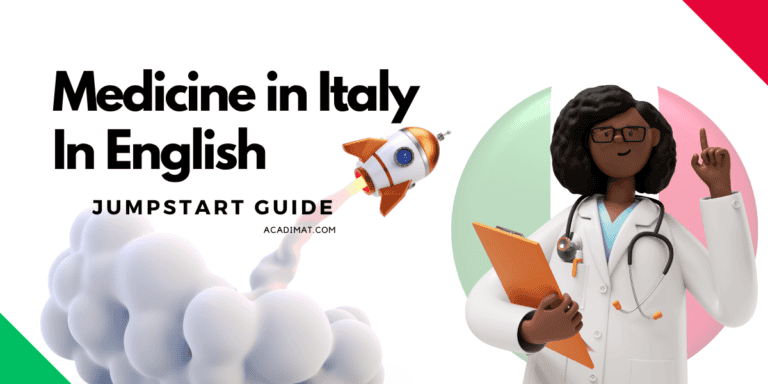
Medicine in Italy Overview
Italy started delivering courses for medicine completely delivered in English with Pavia in 2011, a university found in the North. Soon after, Sapienza (located in Rome) and Milan started their own courses. In a short period of time, medicine in Italy grew to its current state in 2024 with over 20 universities (both private and public) all around Italy having an English medicine and surgery course. There are also 2 universities (Siena and Sapienza) that offer dentistry in English. Every year there are new universities providing medicine in English, with this year marking 3 new universities (Catania, Cagliari, Bolzano) to join the scene. We recommend finishing this article before taking a look at a full list of the medical schools to compare them.
To answer the most commonly asked question, these courses (all teaching and classes) are completely delivered in English throughout their entirety. However, there will be some need for Italian when you start clinical rotations in the hospital, and depending on the university, you may even need a certificate for it, but overall the courses are designed to be completely taught in English. The eventual requirement for Italian can also be avoided, but at a detriment to a medical student as you will be continuously dependent on other people translating for you during clinical rotations, and won’t be able to experience interviewing patients by yourselves. So eventually, learning Italian as a medical student will greatly benefit you, but there is technically no requirement and you can graduate without learning any.
The requirements to apply (which we will talk about in detail later on) are quite simple. First, you need to sit (in person) an exam called the “International Medical Admission Test” (IMAT). There can be a variation in documents required from country to country solely for visa purposes, but from an actual applying to the university perspective, it’s quite straightforward. No need for top scoring high school grades, interviews or other extra curricular activities. Before we talk a bit more about the IMAT, the application process, and what’s needed, let’s briefly talk about some of the universities. If you want to read in detail about each of them, we have an article that covers every single medical school in Italy (linked again at the bottom of the page, but we recommend that you check it out after you’re done reading this article).
What Universities offer Medicine in English?
As a quick rundown, there are ~15 public universities which on average cost €150-2500 EUR a year, and 5 private universities which cost €17,000-20,000 EUR a year. The huge range of tuition, especially for the public medical schools, is mostly due to the fact that all of them offer income-based reductions (so fees go as low as €156 EUR per year), as well as very generous scholarships, even if you’re not Italian. If you don’t qualify for any of these reductions, you still don’t need to worry about paying more than €3,000 Euro a year for the public medical schools. All of the public universities require the same one exam to apply (the IMAT), the score of which determines whether you’re accepted or not, whereas the private universities such as Humanitas, Cattolica, etc., all have their own admission exam you would need to apply for separately.
Where are they located?
While there are around 20 universities in total, they are split across 14 cities located all over Italy, with 3 of them being located on islands. Each city has something unique to offer and they are all different from each other in terms of cost of living, internationality, population sizes, etc. The following cities all have medicine in English courses:
- Cagliari, on the island of Sardegna (1 university)
- Messina and Catania, on the island of Sicily (2 universities)
- Bari
- Naples (2 universities)
- Rome (2 public, 1 dentistry, and 3 private universities)
- Parma
- Padova
- Pavia
- Siena (dentistry only)
- Bologna
- Ancona
- Turin
- Milan (2 public and 2 private universities)
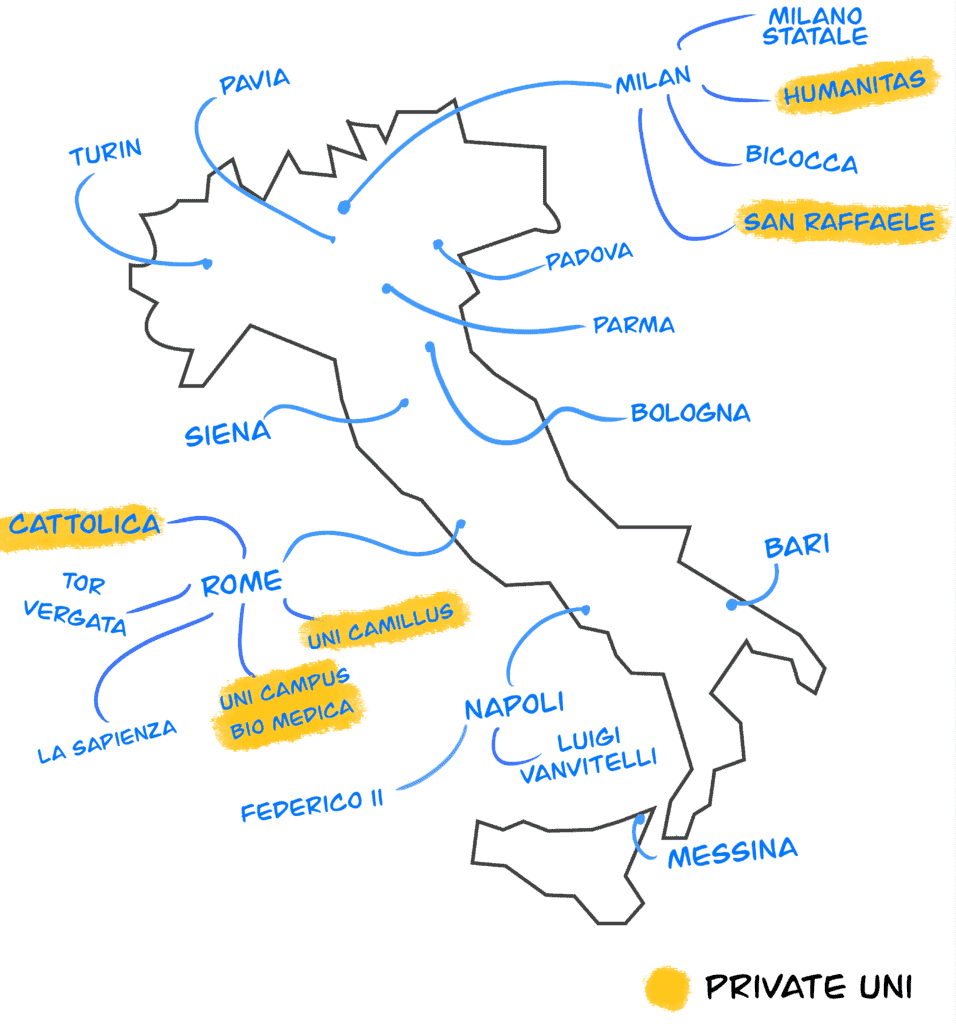
Are there scholarships available?
Every region where a university is located has its own scholarship body that decides the available amount of funds and requirements for students to be able to take advantage of them. In our content, we generally refer to these as “needs-based scholarships”. They are completely dependent on your family income, which is shown through a document called the ISEE. With this type of scholarship, you can receive free accommodation, free meals, and even a stipend, all depending on your family’s annual income and owned assets (such as land, houses, etc). There is generally a mandatory minimum number of credits to acquire every year in order to keep it, and there might additionally be a minimum exam average.
Additionally, each university not only offers a reduction of fees based on the ISEE, but they also offer what we refer to in our content as “merit-based scholarships”. In certain universities, having the highest average in your class, for example, can lead to further reductions in your annual fees regardless of income, as well as allowing you to apply to what are referred to as “borse” (plural), which are essentially part-time jobs with the university that you are paid for.
We recommend reading the following articles for a better overview:
How many universities can I apply to?
If you are an EU student, you can apply to all of the public universities simultaneously via the Universitaly portal and then just complete the IMAT exam. However, if you are a non-EU student, you can only apply to one public university and will be completing the IMAT exam just to try and gain admission there. Depending on your local consulate regulations (only for non-EU students), it is possible to apply for one public and one private university; however, this can change from year to year, so please check with them.
The IMAT Exam
The IMAT exam is technically the only requirement to be admitted to the public universities. It is a multiple-choice question exam that covers topics in Biology, Chemistry, Physics & Mathematics, as well as Logical Reasoning and some General Knowledge. The exact specifications can change year to year (you can find the latest 2024 IMAT specification here); however, historically, the facts have been:
- It’s 60 questions
- It’s scored out of 90 points
- Each correct answer is +1.5 points, and each incorrect answer is -0.4 points (empty answers net 0)
- You have around 100 minutes to complete the test.
- It is only conducted in person
- The distribution of question numbers can change year to year, but generally, the most questions are in the order of Biology, Chemistry, Logical Reasoning, Physics & Maths, and General Knowledge
- The exam is held once a year in late September/October (you take the exam the same year you plan on enrolling, aiming to start classes 1 month after you take the exam)
IMAT Syllabus
We can’t recommend enough that you open in a new tab our article on the “detailed IMAT Syllabus” to see the following laid out in a much more neat way. The following is a brief summary for all of the different sections.
Biology:
The biology syllabus covers a broad range of topics to understand the fundamentals of living organisms. It begins with the chemistry of life, exploring organic molecules, enzymes, and the significance of weak interactions. The syllabus covers cell biology thoroughly, including cell theory, the distinctions between prokaryotic and eukaryotic cells, cellular structures and their functions, as well as the mechanisms of cell membrane transport. Reproductive biology is discussed through the cell cycle, mitosis, meiosis, and both sexual and asexual reproduction. Genetics is a major focus, covering Mendelian laws, chromosomal theories, molecular genetics, and the impact of mutations and selection on evolution. The syllabus also touches on biotechnology, specifically recombinant DNA technology. Finally, it addresses bioenergetics and physiological processes such as photosynthesis and respiration, alongside the anatomy and physiology of animals and humans, especially bodily systems and homeostasis.
Chemistry:
The chemistry syllabus requires many fundamental concepts, starting with the constitution of matter, detailing states of aggregation, and differentiating between heterogeneous and homogeneous systems, elements, and compounds. It covers the laws governing perfect gases and goes into atomic structure, including particles, atomic and mass numbers, isotopes, and electronic configurations, linking these to the periodic table where elements are organized by groups and periods, highlighting periodic properties like atomic radius and ionization potential. Different types of chemical bonds—ionic, covalent, and metallic—and their characteristics such as bond energy and polarity are also covered. Inorganic chemistry focuses on the nomenclature and properties of compounds like oxides and acids. Key concepts in stoichiometry, solution chemistry, chemical equilibria, kinetics, and catalysis are examined. Oxidation-reduction processes are discussed alongside the essentials of acids, bases, pH, and buffer solutions. Lastly, it introduces organic chemistry, detailing carbon bonding, structural formulas, functional groups, and basic nomenclature, encompassing a range of organic compounds from hydrocarbons to esters and amides.
Physics:
The physics syllabus covers various fundamental concepts and principles. Physical quantities and their measurement include understanding fundamental and derived quantities, unit systems, and vector operations. Kinematics covers motion, velocity, acceleration, and types of motion such as uniform and harmonic. Dynamics involves force interactions, inertia, mass, and principles like momentum conservation and mechanical energy. Fluid mechanics addresses fluid properties, pressure principles, and fluid dynamics, including Bernoulli’s equation. Thermodynamics explores temperature, heat transfer, state changes, and gas laws. Electricity and electromagnetism focus on electric charges, fields, capacitance, current, resistance, and electromagnetism, including Ohm’s law and electromagnetic induction.
Maths:
The mathematics syllabus covers a range of topics essential for a strong foundation. Number sets and algebra include natural, integer, rational, and real numbers, with operations, proportions, percentages, powers, radicals, logarithms, combinatorial calculus, algebraic expressions, polynomials, algebraic fractions, and equations and inequalities of first and second degree. Functions focus on their fundamentals, graphical representations, elementary functions (algebraic, exponential, logarithmic, trigonometric), compound and inverse functions, and trigonometric equations and inequalities. Geometry addresses polygons, circles, measurement of lengths, surfaces, and volumes, isometries, similarities, geometric places, angle measurement, trigonometric formulas, and triangle resolution. The Cartesian plane includes points, lines, conic sections, and the Pythagorean and Euclid’s theorems. Probability and statistics cover frequency distributions, graphical representations, random experiments, events, and probability.
Logical Reasoning:
This section primarily evaluates your ability to comprehend written English in various forms, as all questions, whether they involve symbolic language or not, are presented in English. You must understand different types of texts, such as scientific articles, fiction, and news items, focusing on identifying specialised vocabulary, textual cohesion, coherence, and extracting specific information. It checks your ability to complete logical arguments given in words or symbols, involving abstract reasoning and various logical thinking skills. Essentially, it assesses how effectively you can apply logical principles to solve problems or construct arguments.
General Knowledge:
It’s quite difficult to prepare for this section and really gives well-rounded candidates an advantage. Questions can be on politics, classical literary works and media, historical events, and worldwide organisations. These questions aim to gauge your understanding of historical and cultural contexts, knowledge of key institutions, and grasp of legal, economic, and citizenship-related concepts.
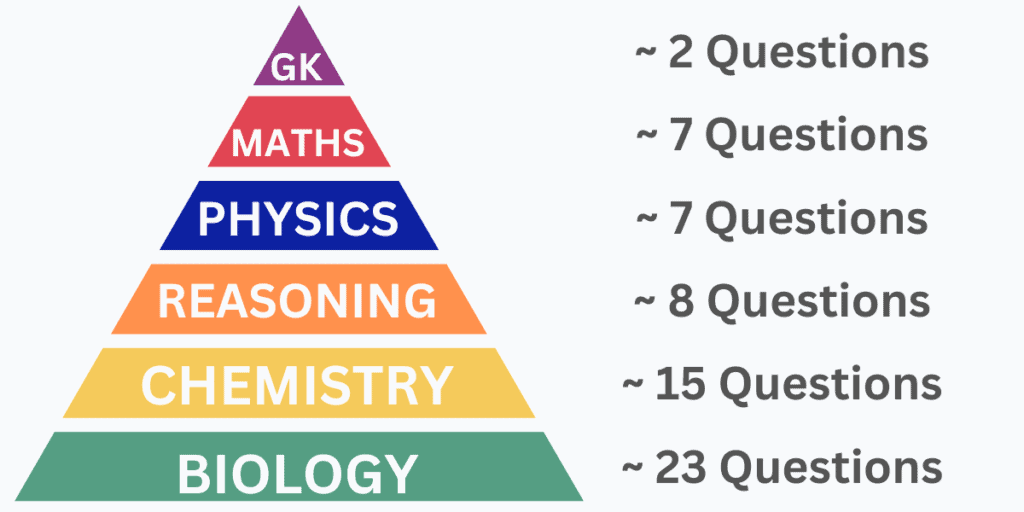
How do I study for the IMAT?
The best way to prepare is by using past IMAT papers. They go all the way back to 2011 and will allow you to get a complete understanding of the types of questions, the depth of theory you need to study, and the overall difficulty of the questions. We have written in-depth articles about how to best use them and how high-scoring students strategized their preparation.
There are also recommended books and free courses you can use, which we have detailed in the “Best Resources for the IMAT” article. As a summary, you can use A-level books, IB books, and free courses on edX and Coursera, as well as YouTube, to help with your preparation.
As of right now, given a cost-to-benefit ratio, we do not recommend any paid IMAT courses.
Is there anything else required?
Technically, there isn’t anything else required, but you will eventually need to acquire something called the DoV, which proves that you’ve completed high school and a total of 12 years of education (details later on in the article). We say technically because there can be other specific document or certification requirements for a visa application from your country of origin or university-specific requirements that need to be submitted upon enrollment, such as an English certificate. Right now, however, you don’t need to overthink this, as we have more in-depth articles to guide you through that process. You should just focus on understanding the overall process before we get to the exact steps for you. Just keep the following in the back of your mind:
- Almost every university will require a DoV upon successful admission and enrollment unless you graduated from a high school in Italy
- Some universities will require an English proficiency test (such as Bicocca), whereas others accept the IMAT as proof of English proficiency.
- For EU students enrolling in one of these universities, they will need to provide it later on
- For non-EU students, this might be required during the pre-enrollment phase
- For visa requirements, embassies can sometimes ask for the most absurd things, like a minimum high school average, passing your local medicine entry exam, or even an Italian language certificate. Please note, however, that this is completely country-dependent and not a requirement as far as the universities are concerned
What's the minimum score for the IMAT?
Explaining the minimum score for the IMAT is a bit complicated because it depends on if you’re EU or if you’re non-EU. Additionally, there isn’t actually a minimum score that the university sets; it’s more so that the score of the lowest-ranking candidate that managed to secure admission becomes that year’s minimum score.
As a very oversimplified explanation:
- Example University has 20 seats for EU, and 20 seats for non-EU
- The top-scoring 20 EU and 20 non-EU candidates are offered admission, and they all enroll
- The 20th student in the EU ranking had a score of 45, and the 20th student in the non-EU ranking had a score of 60
- The non-EU cutoff for Example University is now 60, and the EU cutoff is now 45
In reality, if you’re an EU student, the IMAT scrolling is much more complicated to understand, but if you’re a non-EU student, the system is a lot more straightforward. The reason for this is because EU students can simultaneously apply to every public medical school in Italy at the same time, but non-EU students can only choose one university to apply to.
Here are some resources that we recommend reading once you’re done with this guide:
So How do I Apply to Medicine in Italy?
The process is different if you’re EU or non-EU, but in this section, we’ll try to give a general timeline of the process:
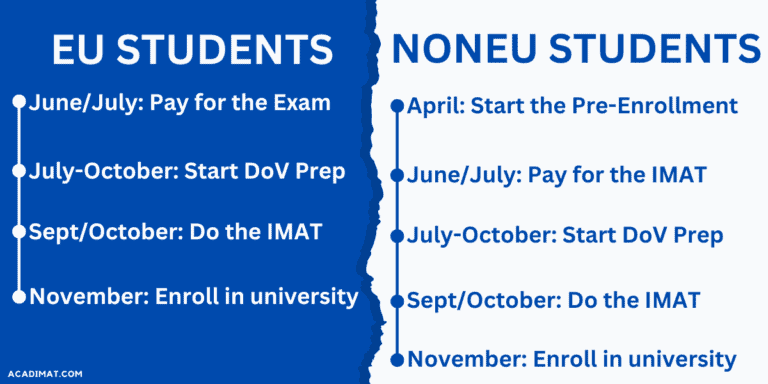
Application timeline for EU students
EU-Students
For a much more detailed guide please read our article on “How to Apply to Medical School in Italy as an EU Student“.
Sometime in June/July, the registration for the IMAT exam will open on Universitaly. You will need to pay for the exam and choose which test centre you would like to do the exam in. The exam has to be completed in person at an approved test centre, the list of which is usually announced in a “call to applicants” (BANDO) released by the Italian Ministry of Education (MIUR) every year. If you’re curious, you can see the most current one translated into English here.
You generally have ~3 weeks to sign up and complete the payment. If you’ve already finished high school/are about to, this is a good time to email your local consulate to ask them about a list of documents necessary to create something called the previously mentioned DoV, the document that essentially certifies you’ve completed 12 years of education. The process will be slightly different from country to country, but it’s good to be informed now about what the exact process will be.
In September/October, you will take the IMAT exam and, within a month, be flying to the city where the university you’ve been accepted into is located to complete your enrollment. You will have hopefully completed your DoV by now and will use it when you are enrolling. That’s it, really 🙂
When is pre-enrollment for Non-EU students?
Unfortunately, applying to medical school in Italy as a non-EU student is a much more involved process due to visa requirements. We recommend reading this guide on how to apply to the IMAT as a non-EU as an excellent additional resource, however lets go through it briefly below.
Sometime during Spring (usually late April – May), a process called pre-enrollment will open on Universitaly. This process is to help with your visa application later on and will ask for some specific documents from you, such as your ID, high school transcript, etc. During this process, you will need to select your first-choice university that you wish to apply to.
You should contact your local embassy to ask for the details on the documents needed for a visa ASAP as you might need things like an English certificate or even an Italian certificate. It is even possible that, depending on the university you’re applying to, there are minimum grades required from high school.
Sometime in June/July, the registration for the IMAT exam will open, where you will pay for the exam, confirm your first-choice university, and select a test centre you wish to complete the exam in. The list of test centres around the world changes year to year, and the approved ones for that year are usually announced in a MUR bando.
In September/October, you will need to complete the IMAT exam and hopefully, within a month, receive an email that you have been accepted into the university of your choice. You then need to apply to the consulate of your home country to apply for a visa.
List of Next Steps
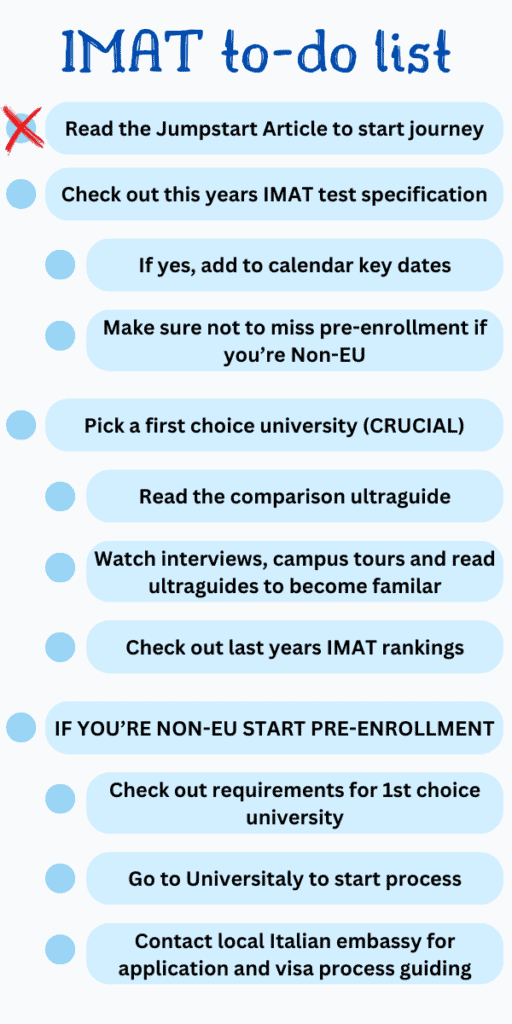
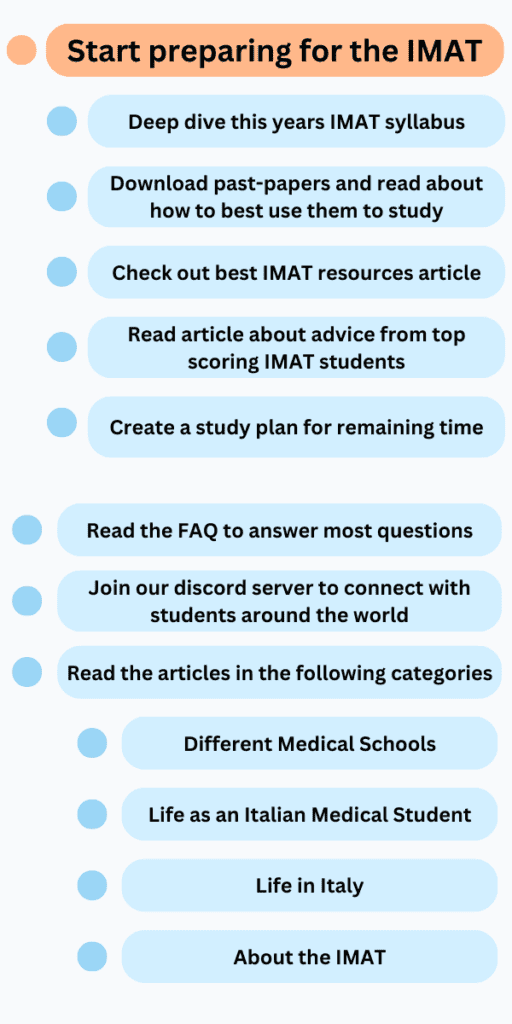
Recommended Further Reading
- Comprehensive overview of every medical school in Italy
- Interviews with medical students in Italy
- How much is medical school in Italy
- Scholarships for medical students in Italy
- How to apply as a non-eu student
- How to apply as an EU student
- How EU scrolling works
- What is the minimum number of points for the IMAT
- Previous IMAT Rankings
- IMAT Past papers
- Best IMAT books
- IMAT strategies to get a high score
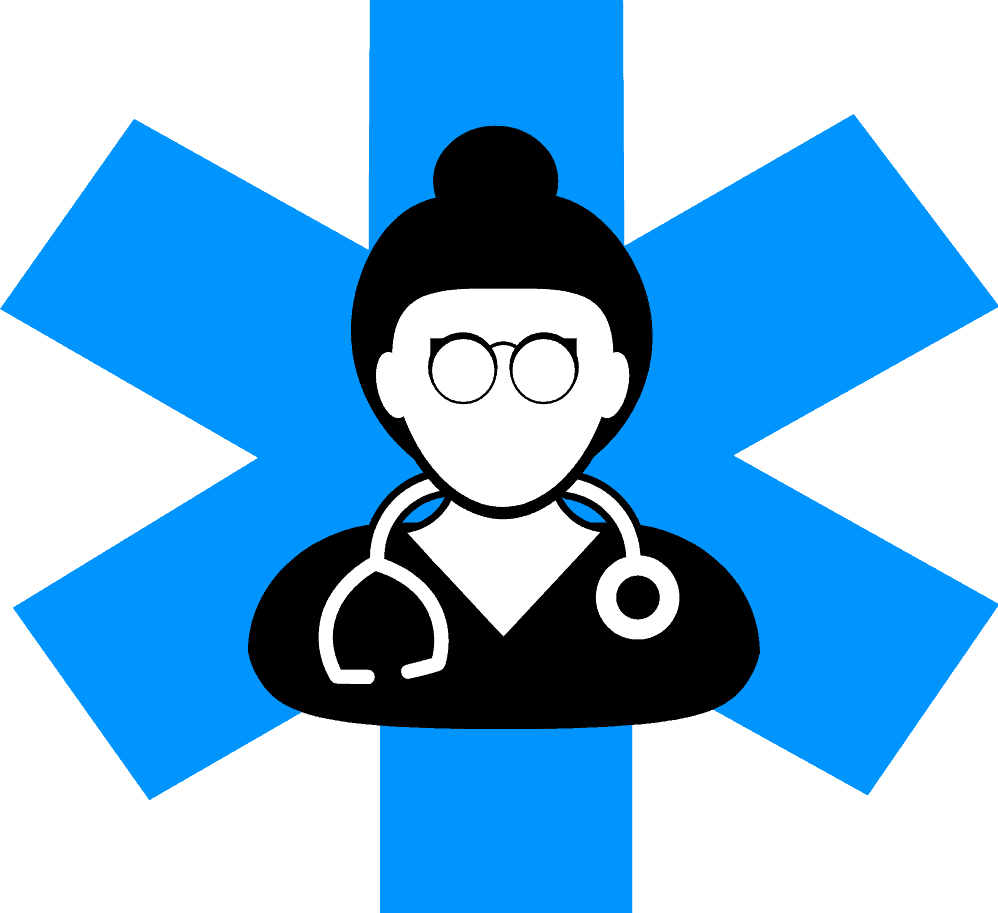

18 thoughts on “Medicine in Italy: Jumpstart Guide (Start Here)”
Hi, So you sit the IMAT september/october, and enroll in November, so when do classes start?
It depends. They usually start two weeks after you get the IMAT results, which is usually around October/November. 🙂
As a non-EU student studying at the medical faculty of a private university in Italy, can I apply for the IMAT and take the exam under EU student status?
It ultimately depends on the uni. You need to see if unis count an Italian permit for study as EU-equivalent status. Please contact the unis you are interested in for the most accurate information!
I was looking into tuition fees for Sapienza as a non-EU student, and it says on the website: Students who earn income in foreign countries and who therefore cannot produce the ISEE declaration for the right to university study for income produced in Italy pay a fixed contribution of a different amount depending on the country of origin. Now, my country is in Band A and it says the total is 300 euros. Does that mean that for me the tuition fee per year is 300 euros? What’s confusing me is ”fixed contribution” is that another term for tuition?
Yes, your tuition fee is 300 euros for Sapienza, plus any tax and government fees.
Wow this is actually the most comprehensive start guide to the IMAT and medicine in Italy that I’ve ever seen
Thank you!!
im an egyptian native arab living in uae and planning to study medicine and surgery in university of bologna as an international student, i wanted to know whats the GPA they need, in percentage , like 90% or smth? also do they ask for grade 10 and 11 marks or only grade 12 senior year high school, and for the scholarship which i needed full tuition fee coverage, would i need to do SAT exam to get it? also is SAT or ACT mandatory for the college admission from american system students? and im planning to enter 2025-2026 academic year there, is it possible for me to have the contact number for you i had many questions regarding studying there
For students completing the US system you need to have 3AP subjects in medicine related fields (like chemistry, biology, physics, maths, etc.). I do not give out my personal information, but I’m quite active in the medicine in Italy discord server.
Hey, loved this article. I am very confused about choosing my university as of now for 2025 as a non eu student. I have followed you articles and videos, but when i was trying to decide using your various criteria to consider I wasn’t able to decide on one university to put as my first choice. This happened so because when i was considering what city to live in and then seeing the latest 2024 IMAT cut off for that university and looking at the number of non eu seats, i become very nervous about my choice. Looking at all the things to consider while choosing one university lead me to a more diverging conclusion. I am going through more of your articles and videos, but was hoping for some more guidance. Such as maybe a new video concising about choosing university, but looking at the new competition, seats etc. as they have changed a lot from what it was 3 years ago. It would also be very helpful if i could perhaps contact any students already studying there through gmail, so that i can get some guidance.
I can definitely work on a video to help choose a first choice university, but in regards to contacting students if they haven’t left their socials (which we put in the description box of the youtube videos) it means they’ve been asked not to be contacted.
I am a student currently studying in grade 12, my final exams are in feb and my results will only be available by may. my question is that should I start my pre enrolment after i get my results or can I start from now with a HOPE letter (A letter of assurance that I will pass 12th)????
Pre-enrollment is usually open until quite late in the summer. If you get your results in May you should be more than ok!
Hey, iam a son to an italian father and holding a permesso di soggiorno per motivi familiari, am i considered as EU or non EU?
If you have had a valid permesso di soggiorno especially for a period of time, most universities will consider you EU.
I have speeling errors in name of mine in my marksheet does it will make problem in making dov?
This is something you need to clarify with the embassy to make sure it doesn’t cause any problems in the future.